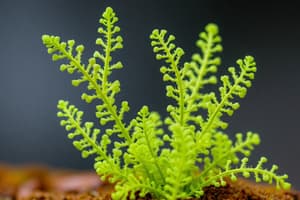Podcast
Questions and Answers
What is primarily responsible for producing male gametes in gymnosperms?
What is primarily responsible for producing male gametes in gymnosperms?
- Androecium
- Microsporangium (correct)
- Megasporangium
- Gynoecium
Angiosperms are characterized by seeds that are free and not enclosed in any structure.
Angiosperms are characterized by seeds that are free and not enclosed in any structure.
False (B)
Name one distinguishing feature of angiosperms compared to gymnosperms.
Name one distinguishing feature of angiosperms compared to gymnosperms.
Angiosperms produce flowers.
The __________ is the female reproductive part of a flower in angiosperms.
The __________ is the female reproductive part of a flower in angiosperms.
Match the reproductive structures with their respective plant type:
Match the reproductive structures with their respective plant type:
Which of the following is NOT a key feature of angiosperms?
Which of the following is NOT a key feature of angiosperms?
The sporophyte of gymnosperms is the tree itself.
The sporophyte of gymnosperms is the tree itself.
How many species of angiosperms are estimated to exist?
How many species of angiosperms are estimated to exist?
What is the primary reproductive structure in gymnosperms?
What is the primary reproductive structure in gymnosperms?
Gymnosperms produce seeds that are enclosed inside an ovary.
Gymnosperms produce seeds that are enclosed inside an ovary.
Name one key feature that distinguishes gymnosperms from angiosperms.
Name one key feature that distinguishes gymnosperms from angiosperms.
The _____ of pterophytes acts as their 'leaves' and contains the sori.
The _____ of pterophytes acts as their 'leaves' and contains the sori.
Which of the following phyla contains the largest group of gymnosperms?
Which of the following phyla contains the largest group of gymnosperms?
Match the reproductive structures of gymnosperms to their descriptions:
Match the reproductive structures of gymnosperms to their descriptions:
Rhizoids in pterophytes serve only for anchoring the plants.
Rhizoids in pterophytes serve only for anchoring the plants.
What is the role of the sporangium in gymnosperms?
What is the role of the sporangium in gymnosperms?
Which of the following accurately describes bryophytes?
Which of the following accurately describes bryophytes?
Pterophytes lack a complete vascular system.
Pterophytes lack a complete vascular system.
What are the main reproductive structures of angiosperms?
What are the main reproductive structures of angiosperms?
The ______________ are stalk-like structures in bryophytes that help in spore dispersion.
The ______________ are stalk-like structures in bryophytes that help in spore dispersion.
Which characteristics distinguish gymnosperms from angiosperms?
Which characteristics distinguish gymnosperms from angiosperms?
Fronds are leaves that are characteristic of pterophytes.
Fronds are leaves that are characteristic of pterophytes.
What is the function of rhizoids in bryophytes?
What is the function of rhizoids in bryophytes?
Match the following plant groups with their characteristics:
Match the following plant groups with their characteristics:
Flashcards are hidden until you start studying
Study Notes
Bryophytes
- Bryophytes are spore-bearing, non-vascular plants, such as mosses.
- They have stems and leaves, but not true roots.
- Instead of roots, they have rhizoids, which are hair-like structures that anchor them in place.
- Bryophytes are moisture-dependent because they need water for survival and reproduction, as it aids in spore dispersion.
- Parts of bryophytes:
- Seta: A stalk-like structure that holds up the capsule, helping in spore dispersion.
- Capsule: A sporophyte that produces, holds, and releases spores.
- Leaves: Bryophyte leaves are considered untrue or incomplete.
- Rhizoids: Rhizoids function as "roots" for bryophytes, but they cannot absorb water. Their sole purpose is to keep the plant anchored down.
Pterophytes
- Pterophytes are spore-bearing plants with a complete vascular system.
- They have fronds, which are their leaves.
- Pterophytes include ferns, horsetails (named for their brush-like stems), and whisk ferns.
- Pterophytes are vascular, meaning they have xylems and phloems, allowing them to grow larger than bryophytes.
- Parts of pterophytes:
- Sorus: A sporophyte that produces and holds spores to be released.
- Sporangium: Part of the sporophyte that releases the spores produced and held by the sori.
- Frond: Fronds act as leaves and are where the sori are usually found.
- Fiddlehead: A young sporophyte that sprouts to provide energy and eventually develops into a frond.
- Prothallium: A male part that produces sperm cells.
- Prothalus: The female counterpart to the prothallium, which produces egg cells.
- Rhizoids: Unlike bryophytes, the rhizoids of pterophytes are able to absorb water.
Gymnosperms
- Gymnosperms are seed-producing plants that do not enclose their seeds inside an ovary.
- They reproduce through cones.
- Gymnosperms are divided into three phyla :
- Cycadophyta: The second largest group of gymnosperms after conifers.
- Ginkgophyta: Contains only one surviving species: Ginkgo biloba (maidenhair tree).
- Coniferophyta: The largest group of gymnosperms, with 600 species, including pine trees and sequoia trees.
- Gymnosperms are vascular plants, meaning they have xylems and phloems, enabling them to grow larger than bryophytes.
- Parts of gymnosperms:
- Male cones: Smaller than female cones and part of the gametophyte. They disintegrate after releasing pollen.
- Female cones: Larger than male cones and also part of the gametophyte. This is where the zygote grows.
- Megasporangium: Produces female gametes (egg cells).
- Microsporangium: Produces male gametes (sperm cells).
- Sporophyte: The gymnosperm tree itself.
Angiosperms
- Angiosperms are seed-producing plants with flowers where their seeds are enclosed in an ovary.
- They are the largest and most diverse group of plants, with over 300,000 species.
- They are vascular, meaning they have xylems and phloems, allowing them to grow larger than bryophytes.
- Parts of angiosperms
- Gynoecium: The female reproductive part, located in the innermost whorl of a flower. It consists of the ovary, ovules, stigma, and style.
- Androecium: The male reproductive part. It consists of the pollen grain, microsporangia, anther, and filament.
Studying That Suits You
Use AI to generate personalized quizzes and flashcards to suit your learning preferences.




